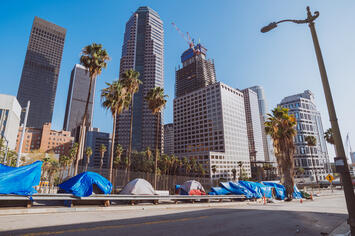
California’s leaders might see themselves as a vanguard of progressive and eco-friendly values. But in reality, their draconian climate policies have created a racially segregated state more akin to the pre-Civil Rights era South. As Attorney Jennifer Hernandez puts in a startling new report for the environmentalist Breakthrough Institute, California has been plunged into “a new Green Jim Crow era”.
The “soaring environmental rhetoric of the state’s affluent, largely white technocratic leadership”, she concludes, is “deepening the state’s shameful legacy of racial injustice”. Certainly, the impact is stark. California now suffers the nation’s worst cost-adjusted poverty rate; and according to the United Way of California, more than 30% of California residents lack sufficient income to meet basic costs of living, even after accounting for public assistance programmes. Those struggling families include half of Latino and 40% of black residents.
There are two main factors driving this “new Green Jim Crow era”. The first, and most obvious, is California’s energy policy, which has made the state’s electricity and gas prices the highest on the mainland, with electricity prices 50% above the national average and gasoline costs that exceed even import-reliant Hawaii in the centre of the Pacific Ocean.
This surge in prices derives from the state’s obsession — shared by the ruling tech oligarchs — with renewable energy and the elimination of fossil fuels. Yet as a recent Massachusetts Institute of Technology (MIT) report has shown, over-reliance on renewables is costly, because it requires the production of massive (and environmentally unfriendly) battery-storage capacity — the price of which is invariably passed on to the taxpayer.
This is not bad news for the tech oligarchs, who have been prominent among those profiting from “clean energy” investments. But many other Californians, primarily those in the less temperate interior, find themselves falling into energy poverty or are dependent on state subsidies that raise electricity prices for businesses and the middle class. Black and Latino households are already forced to pay from 20 to 43% more of their household incomes on energy than white households. Last year, more than 4 million households in California (30% of the total) experienced energy poverty.
These policies have also had the secondary effect of driving out many of the blue-collar industries — manufacturing, construction, energy — that have traditionally employed ambitious, upwardly mobile minority families. While the small, insulated, post-industrial urban elite bloats up on cash and stokes its virtue, over the past decade California has lost 1.6 million above-average-paying jobs, more than twice as many as any other state.
This attrition reflects in part the torpor of the state’s industrial sector; California now sits in the bottom half of states in manufacturing-sector employment growth, ranking 44th last year, easily outpaced by competitors such as Nevada, Kentucky, Michigan and Florida. Even without adjusting for costs, no Californian city ranks in the US top ten in terms of well-paying blue-collar jobs, but four — Ventura, Los Angeles, San Jose, and San Diego — sit among the bottom ten.
This is hardly surprising when you consider that California’s largest economic pogrom is directed at the state’s most important energy industry: gas and oil development. Two years ago, Governor Newsom — who has been described as “California’s champion virtue signaler” — announced plans to shut the entire industry down. His latest decree, announced in April, confirmed his intention to phase out oil extraction. Perhaps it could be considered a noble campaign, if it weren’t for the fact that California chooses instead to import its oil from such enlightened states as Saudi Arabia.
And while this shift will not cause much pain in Malibu or Menlo Park, where the wealthy can continue to tool around in their BMWs, in Bakersfield, where the industry is centered, or around the coastal refineries, the impact could be catastrophic. According to a study by the Los Angeles Economic Development Corporation, these dictates threaten over 366,000 high-paying, largely blue-collar jobs — roughly half of which are held by people of colour.
Read the rest of this piece at UnHerd.
Joel Kotkin is the author of The Coming of Neo-Feudalism: A Warning to the Global Middle Class. He is the Presidential Fellow in Urban Futures at Chapman University and Executive Director for Urban Reform Institute. Learn more at joelkotkin.com and follow him on Twitter @joelkotkin.













Sounds like
the Central Valley needs to split off from coastal Calif., and the working-class areas of Los Angeles need to elect different legislators.